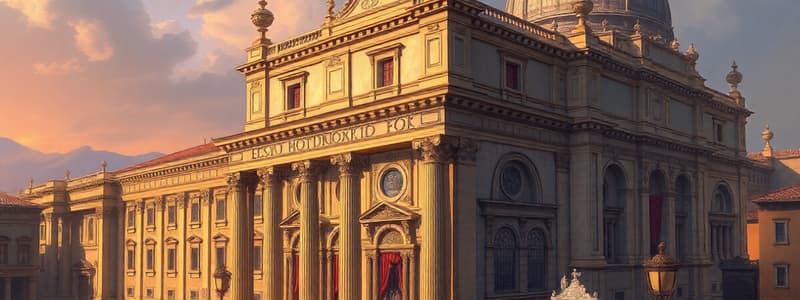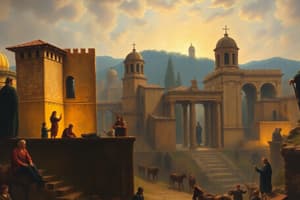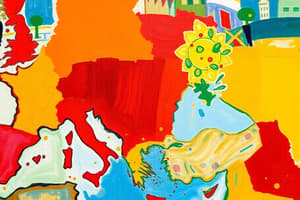Podcast
Questions and Answers
The Western Roman Empire was conquered by various ______ groups in the 5th century AD.
The Western Roman Empire was conquered by various ______ groups in the 5th century AD.
Barbarian
The last Roman Emperor was ______ Augustus, who was deposed by the Barbarian Odoacer in 476 AD.
The last Roman Emperor was ______ Augustus, who was deposed by the Barbarian Odoacer in 476 AD.
Romulus
The size of the Empire made it difficult to manage distant ______ and wars.
The size of the Empire made it difficult to manage distant ______ and wars.
provinces
The Gothic Wars occurred between ______ and 382 AD.
The Gothic Wars occurred between ______ and 382 AD.
Alaric I led a rebellion against the Romans after Emperor ______ I died.
Alaric I led a rebellion against the Romans after Emperor ______ I died.
The Vandals and Alans were led by King ______ during their invasion in 429 AD.
The Vandals and Alans were led by King ______ during their invasion in 429 AD.
During the Western Roman Empire's decline, recruitment problems in the army forced the empire to hire foreign ______.
During the Western Roman Empire's decline, recruitment problems in the army forced the empire to hire foreign ______.
The aristocracy grew increasingly powerful and more interested in ______ than governance.
The aristocracy grew increasingly powerful and more interested in ______ than governance.
Odoacer was unhappy with Orestes' refusal of land for the Barbarian ______.
Odoacer was unhappy with Orestes' refusal of land for the Barbarian ______.
The Visigoths allied with the Romans to drive out the ______ but later took over parts of Hispania.
The Visigoths allied with the Romans to drive out the ______ but later took over parts of Hispania.
Flashcards are hidden until you start studying
Study Notes
The Fall of the Roman Empire
- The Western Roman Empire was conquered by various Barbarian groups in the 5th century AD.
- The Eastern Roman Empire (Byzantine Empire) survived until 1453.
- The last Roman Emperor was Romulus Augustus, who was deposed by the Barbarian Odoacer in 476 AD.
Reasons for the Decline of the Roman Empire
- The size of the Empire made it difficult to manage distant provinces and wars.
- The Western Roman Empire became bankrupt as it was poorer than the Eastern Roman Empire and required a large army.
- The Western Roman Empire lost its source of slaves which crippled the economy.
- Recruitment problems in the army forced the empire to hire foreign mercenaries.
- Many later Emperors were incompetent and had little influence over the aristocracy.
- The aristocracy grew increasingly powerful and more interested in profit than governance.
- The rise of Christianity, which opposed the Emperor’s worship as gods, undermined their authority.
Key Events in the Fall of the Western Roman Empire
- The Gothic Wars (376-382 AD):
- The Goths sought refuge from the Huns in 376 AD
- The Romans treated the Goths poorly, leading to famine and a rebellion.
- The Battle of Adrianople (378 AD) resulted in the destruction of a large portion of the Roman army.
- Alaric I and the Sack of Rome (410 AD):
- Alaric, a Visigoth King, led a rebellion against the Romans after Emperor Theodosius I died.
- Alaric besieged Rome three times and sacked the city in 410 AD.
- Constantine III (407-411 AD):
- Constantine rose up against Emperor Honorius in 407 AD.
- Constantine conquered Britannia and Gaul.
- The Romans in Britannia revolted against Constantine and drove out his forces.
- The Vandals and Alan’s Invasion (429 AD):
- The Vandals and Alans led by King Gaiseric moved through the Strait of Gibraltar and conquered North Africa.
- They also conquered Sicily and several Mediterranean islands, establishing the Vandal Kingdom.
- The Visigoths (418-475 AD):
- The Visigoths conquered parts of southern Gaul.
- They allied with the Romans to drive out the barbarians but later took over the last part of Hispania.
- Odoacer (476 AD):
- Odoacer was an official in the Roman army who was unhappy with Orestes' refusal of land for the Barbarian troops.
- He killed Orestes and deposed the 16-year-old Romulus Augustus in 476 AD.
- He then sent the Imperial insignia to the Eastern Roman Emperor, signalling the end of the Western Roman Empire.
Legacy of the Roman Empire
- The Eastern Roman Empire (Byzantine Empire) survived until 1453.
- Charlemagne, the King of the Franks, was crowned Holy Roman Emperor in 800 AD.
- Roman culture has had a lasting impact on the Western world, including language and religion.
- Roman technology and infrastructure helped shape the development of Europe in the Middle Ages.
The Fall of the Western Roman Empire
- The Western Roman Empire was conquered by Barbarian groups from the 5th century AD.
- The last Roman Emperor was Romulus Augustus, deposed by the Barbarian leader Odoacer in 476 AD.
- The Eastern Roman Empire (also known as the Byzantine Empire) survived until 1453.
Reasons for the Decline of the Roman Empire
- The vast size of the empire created challenges in managing distant provinces and wars.
- The Western Roman Empire faced economic difficulties due to poverty compared to the East, requiring a large army to maintain control.
- The loss of slave labor, a vital source for the economy, crippled the Western Empire.
- Recruitment issues within the army forced the empire to rely on foreign mercenaries.
- Many later emperors lacked competence and struggled to control the powerful aristocracy.
- The aristocracy gained significant power and prioritized personal profit over effective governance.
- The rise of Christianity, opposing the Emperor’s worship as gods, undermined their authority.
Key Events in the Fall of the Western Roman Empire
- The Gothic Wars (376-382 AD):
- The Goths sought refuge from the Huns in 376 AD.
- The Romans mistreated the Goths, leading to famine and rebellion.
- The Battle of Adrianople (378 AD) resulted in a devastating defeat for the Roman army.
- Alaric I and the Sack of Rome (410 AD):
- Alaric, a Visigoth King, led a rebellion after the death of Emperor Theodosius I.
- Alaric besieged Rome three times and sacked the city in 410 AD.
- Constantine III (407-411 AD):
- Constantine rose against Emperor Honorius in 407 AD.
- Constantine conquered Britannia and Gaul.
- The Romans in Britannia revolted against Constantine and expelled his forces.
- The Vandals and Alan’s Invasion (429 AD):
- The Vandals and Alans led by King Gaiseric crossed the Strait of Gibraltar and conquered North Africa.
- The Vandals conquered Sicily and several Mediterranean islands, establishing the Vandal Kingdom.
- The Visigoths (418-475 AD):
- The Visigoths conquered parts of southern Gaul.
- They allied with the Romans to drive out other barbarians but eventually took over the remaining parts of Hispania.
- Odoacer (476 AD):
- Odoacer, an official in the Roman army, was dissatisfied with Orestes' refusal to grant land to Barbarian troops.
- Odoacer killed Orestes and deposed the 16-year-old Romulus Augustus in 476 AD.
- He sent the Imperial insignia to the Eastern Roman Emperor, marking the end of the Western Roman Empire.
Legacy of the Roman Empire
- The Eastern Roman Empire (Byzantine Empire) lasted until 1453.
- Charlemagne, the King of the Franks, was crowned Holy Roman Emperor in 800 AD.
- Roman culture has had a lasting impact on the Western world, including language and religion.
- Roman technology and infrastructure played a crucial role in shaping the development of Europe during the Middle Ages.
Studying That Suits You
Use AI to generate personalized quizzes and flashcards to suit your learning preferences.




